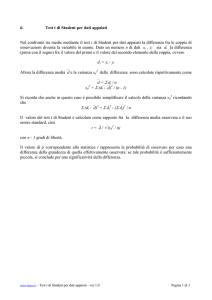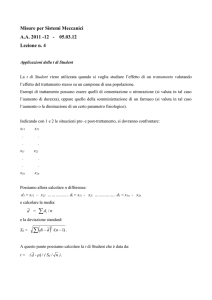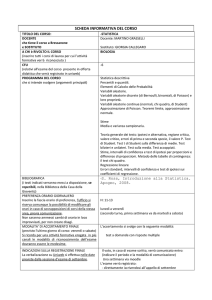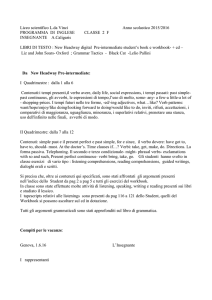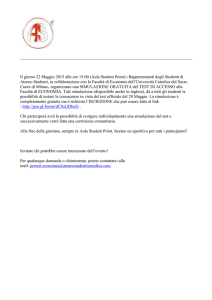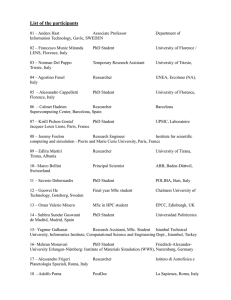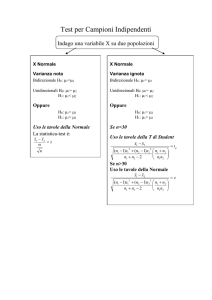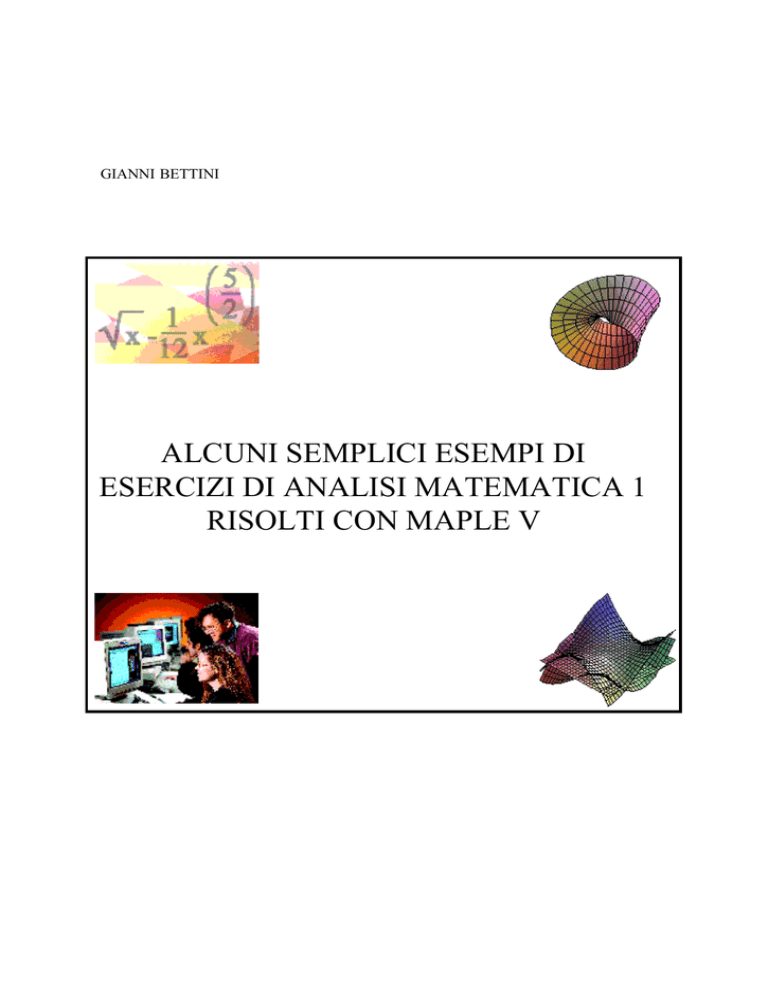
GIANNI BETTINI
ALCUNI SEMPLICI ESEMPI DI
ESERCIZI DI ANALISI MATEMATICA 1
RISOLTI CON MAPLE V
A Isabella
INDICE
Prefazione
1 Raccolta di limiti
Esempio 1.1
Esempio 1.2
Esempio 1.3
Esempio 1.4
Esempio 1.5
Esempio 1.6
Esempio 1.7
2 Calcolo di limiti utilizzando il polinomio di Taylor
Esempio 2.1
Esempio 2.2
Esempio 2.3
3 Studio di funzioni parametriche
Esempio 3.1
Esempio 3.2
Esempio 3.3
4 Valutazione dell’errore che si commette approssimando una funzione con il
polinomio di Taylor
Esempio 4.1
5 Metodi approssimati per il calcolo delle aree
Esempio 5.1
Esempio 5.2
Esempio 5.3
Durante il primo semestre dell’Anno Accademico 1998-99 del Diploma di Laurea
in Ingegneria Meccanica dell’Università degli Studi di Firenze il corso di Analisi
Matematica 1 è stato oggetto del tentativo di avvicinarsi all’Analisi Matematica
utilizzando un approccio “ibrido” che ai teoremi e alle nozioni classiche abbinasse
l’uso del calcolatore, ormai irrinunciabile strumento quotidiano di lavoro.
Il presente libretto riunisce alcuni semplici esempi di questo tipo di approccio,
realizzati con il programma di calcolo formale MapleV® Release 4 - Student Edition.
Proprio per questo tentativo di conciliare le tecniche tradizionali con la facilità di
calcolo di un elaboratore, gli esempi proposti potranno sembrare (e non è detto che
non lo siano!) risolti in maniera artificiosa e tortuosa mentre una via più diretta
appare evidente.
Desidero ringraziare tutti gli studenti del Corso per il piacevole rapporto
instauratosi e la costruttiva collaborazione a questa mia prima esperienza di
codocenza; il Prof. Giovanni Frosali, titolare del Corso, e il futuro collega Mauro
Baroni per l’aiuto e i frequenti, benché immeritati, attestati di stima; un
ringraziamento anche all’Ing. Isabella Villani (mia compagna di vita), che mi
sopporta da quando studiavamo insieme Analisi 2 e che anche in questo caso ho
stressato per avere giudizi e suggerimenti; una menzione particolare merita infine il
Prof. Pietro Zecca, con il quale ho sostenuto gli esami di Analisi Matematica 1,
Analisi Matematica 2 e Metodi Matematici per l’Ingegneria: tutta la mia ignoranza in
materia è esclusivamente colpa sua.
Spero che questo libretto possa aiutare altri studenti ad avere un rapporto meno
conflittuale con l’Analisi Matematica.
Gianni Bettini
Esempio 1.1
x −8
Supponiamo di voler calcolare a = lim
x→0 x − 2
STUDENT > f1 := (x^3-8)/(x-2)
STUDENT > subs(x=2,f1);
3
Error, division by zero
STUDENT > plot(f1,x=-2...4);
25
20
15
10
5
-2
-1
0
1
STUDENT > subs(x=2,f1);
Error, division by zero
STUDENT > simplify(f1);
x +2x+4
2
STUDENT > lim f1
x→2
12
STUDENT >
2
x
3
4
Esempio 1.2
Supponiamo di voler calcolare a = lim
x→π
STUDENT > f2 :=
sin( x3 )
x−π
sin( x )
π−x
STUDENT > plot(f2,x=-infinity...infinity);
0
-infinity
x
STUDENT > plot(f2,x=0...2*Pi);
1
0.8
0.6
0.4
0.2
0
1
2
3
x
STUDENT > subs(x=Pi,f2);
Error, division by zero
STUDENT >
lim
f2
x → ( 2 π)
0
4
5
6
infinity
Esempio 1.3
Supponiamo di voler calcolare a = lim
sin( x3 )
x
STUDENT > f:=(sin(x^3))/x:
STUDENT > plot(f,x=-infinity...infinity);
x→0
0
-infinity
infinity
x
STUDENT > plot(f,x=-1...1);
0.8
0.6
0.4
0.2
-1
-0.5
0
0.5
x
1
Vediamo la f come una frazione ed andiamo ad analizzare il comportamento del numeratore e del
denominatore:
STUDENT > fn:=numer(f);
3
fn := sin( x )
STUDENT > fd:=denom(f);
fd := x
STUDENT > plot([fd,fn],x=-1/2...1/2);
0.4
0.2
-0.4
-0.2
0
0.2
x
-0.2
-0.4
STUDENT > limit((sin(x^3))/x,x=0);
0
limiti all'infinito
STUDENT > plot([fd,fn],x=-infinity...0);
0.4
x
-infinity
0
-infinity
STUDENT > limit((sin(x^3))/x,x=-infinity);
0
STUDENT > plot([fd,fn],x=0...+infinity);
infinity
0
infinity
x
STUDENT > limit((sin(x^3))/x,x=+infinity);
0
STUDENT >
Esempio 1.4
Supponiamo di voler calcolare a = lim
x→0
x+1
x
STUDENT > f4:=sqrt(x+1)/x:
STUDENT > plot(f4,x=-infinity...infinity,y=-infinity...infinity
);
infinity
y
-infinity
0
x
-infinity
STUDENT > plot(f4,x=-1/2...1/2,y=-200...200);
infinity
200
y100
-0.4
-0.2
0
0.2
0.4
x
-100
-200
STUDENT > f4n:=numer(f);
STUDENT > f4d:=denom(f);
STUDENT > plot([f4d,f4n],x=-1...1);
3
f4n := sin( x )
f4d := x
1
0.5
-1
0
-0.5
-0.5
-1
STUDENT > limit(f4n,x=0);
0
STUDENT > limit(f4d,x=0);
0
STUDENT > limit(f4,x=0,left);
−∞
STUDENT > limit(f4,x=0,right);
∞
STUDENT >
0.5
x
1
Esempio 1.5
x−2
Supponiamo di voler calcolare a = lim
log( x ) − log( 2 )
STUDENT > f5:=(2-x)/(log(2)-log(x)):
x→2
STUDENT > plot(f5,x=-infinity...infinity,y=-infinity...infinity
);
infinity
y
0
-infinity
infinity
x
-infinity
STUDENT > plot(f5,x=3/2...5/2,y=0...2);
2
1.5
y 1
0.5
0
1.6
STUDENT > subs(x=2,f5);
1.8
2
x
2.2
2.4
Error, division by zero
STUDENT > f5n:=numer(f5);
f5n := 2 − x
STUDENT > f5d:=denom(f5);
f5d := ln( 2 ) − ln( x )
STUDENT > plot([f5d,f5n],x=0...4);
3
2
1
0
1
2
x
-1
-2
STUDENT > limit(f5n,x=2);
0
STUDENT > limit(f5d,x=2);
0
3
4
STUDENT > limit(f5,x=2);
2
Esempio 1.6
Supponiamo di voler calcolare a = lim
x2
1
cos
x
STUDENT > f6:=(x^2)/cos(1/x):
STUDENT > plot(f6,x=-infinity...infinity,y=-infinity...infinity
);
x→∞
infinity
y
0
-infinity
infinity
x
-infinity
STUDENT > plot(f6,x=0...infinity,y=0...infinity);
infinity
y
0
x
STUDENT > subs(x=infinity,f6);
∞
1
cos
∞
infinity
STUDENT > f6n:=numer(f6);
2
f6n := x
STUDENT > f6d:=denom(f6);
1
f6d := cos
x
STUDENT > plot([f6d,f6n],x=0...infinity);
infinity
0
x
STUDENT >
lim f6n
x→∞
∞
STUDENT >
lim f6d
x→∞
1
STUDENT >
lim f6
x→∞
∞
STUDENT >
infinity
Esempio 1.7
2
( ln( x ) )
Supponiamo di voler calcolare a = lim x
x→0
−1
2
( ln( x ) )
STUDENT > f7 := x
−1
STUDENT > plot(f7,x=-infinity...infinity,y=-infinity...infinity
);
infinity
y
0
-infinity
infinity
x
-infinity
STUDENT > plot(f7,x=0...1,y=-2...2);
2
y1
0
0.2
0.4
x
-1
-2
STUDENT > subs(x=0,f7);
-1
STUDENT >
0.6
0.8
1
Esempio 2.1
Calcolo di limiti utilizzando il polinomio di Taylor
Consideriamo il seguente limite: lim
cos( x ) − ex
x
STUDENT > f:=((cos(x)-exp(x))/x);
x→0
f :=
cos( x ) − ex
x
che ha come valore
STUDENT > lim f
x→0
-1
A tale risultato si può pervenire considerando la f(x) come composizione delle funzioni
x
STUDENT > b := e
STUDENT > c := cos( x )
STUDENT > z := x
Sviluppando tali funzioni elementari con il polinomio di Taylor
STUDENT > d:=taylor(b,x=0,2);
d := 1 + x + O( x2 )
STUDENT > e:=taylor(c,x=0,2);
2
e := 1 + O( x )
Sostituendo nella f(x) alle funzioni elementari la loro approssimazione con il polinomio di Taylor in
modo da non avere più forme indeterminate
STUDENT > g:=subs(b=d,c=e,a);
g := -1
risultato al quale si poteva pervenire anche con il trucco seguente:
x
STUDENT > a := lim
x→0
STUDENT > a := lim
cos( x ) − e
x
cos( x ) − 1 + 1 − ex
x
x→0
STUDENT > a := lim
x→0
cos( x ) − 1
x
+
1 − ex
x
STUDENT > a := 0 − 1
a := -1
verifichiamo graficando la funzione:
STUDENT > plot(f,x=-infinity...infinity,y=-infinity...infinity)
;
infinity
y
0
-infinity
infinity
x
-infinity
Restringiamo il campo di osservazione ad un intorno di x=0
STUDENT > plot( f, x = −2 .. 2, y = −2 .. 2 )
2
y 1
-2
-1
0
-1
-2
ed abbiamo la conferma della bontà del risultato ottenuto.
1
x
2
Esempio 2.2
Calcolo di limiti utilizzando il polinomio di Taylor
Cosideriamo il limite lim
x log( 1 + x ) − tan( x )2
che ha come valore
3
2
2
x + x − sin( x )
STUDENT > f:=(((x*log(1+x))-(tan(x))^2)/(x^3+x^2-sin(x^2)));
x→0
2
f :=
x ln( 1 + x ) − tan( x )
x3 + x2 − sin( x2 )
STUDENT > a:=limit(f,x=0);
a :=
-1
2
x log( 1 + x ) − tan( x )
2
Consideriamo f( x ) :=
come composizione delle seguenti funzioni
3
2
2
x + x − sin( x )
STUDENT > b1 := log( x + 1 )
STUDENT > b2 := tan( x )
STUDENT > b3 := sin( x )
che posso sviluppare con il polinomio di Taylor
STUDENT > c1:=taylor(b1,x=0,3);
c1 := x −
1
2
STUDENT > c2:=taylor(b2,x=0,2);
x2 + O( x3 )
c2 := x + O( x2 )
STUDENT > c3:=taylor(b3,x=0,2);
c3 := x + O( x2 )
e poi ricombinare per ottenere lo sviluppo in serie della f(x) e calcolare il limite. Il polinomio
approssimante la f(x) non presenta più il problema dell'indeterminazione
STUDENT > g:=subs(b1=c1,b2=c2,b3=c3,a);
g :=
-1
2
verifichiamo graficando la funzione:
STUDENT > plot(f,x=-infinity...infinity,y=-infinity...infinity)
;
infinity
y
0
-infinity
infinity
x
-infinity
Restringiamo il campo di osservazione ad un intorno di x=0
STUDENT > plot(f,x=-1...1,y=-1...1);
1
y0.5
-1
-0.5
0
-0.5
-1
STUDENT >
0.5
x
1
Esempio 2.3
Calcolo di limiti utilizzando il polinomio di Taylor
Consideriamo la funzione
STUDENT > f1 :=
( 1 − sin( x ) − cos( x ) ) sin( x )
( 1 − tan( x ) − cos( x ) ) log( x + 1 )
f1 :=
( 1 − sin( x ) − cos( x ) ) sin( x )
( 1 − tan( x ) − cos( x ) ) ln( 1 + x )
Della quale si vuole trovare il valore per x=0. Tale punto non appartiene al dominio della f(x) come si
può verificare sostituendo tale valore:
STUDENT > b:=subs(x=0,f1);
b :=
( 1 − sin( 0 ) − cos( 0 ) ) sin( 0 )
( 1 − tan( 0 ) − cos( 0 ) ) ln( 1 )
STUDENT > simplify(b);
Error, division by zero
Andiamo allora a valutare
STUDENT > c := lim f1
x→0
c := 1
Consideriamo f1 :=
( 1 − sin( x ) − cos( x ) ) sin( x )
( 1 − tan( x ) − cos( x ) ) log( x + 1 )
come composizione delle seguenti funzioni
STUDENT > d1 := 1 − sin( x )
STUDENT > e1 := 1 − tan( x )
STUDENT > g1 := cos( x )
che sviluppo come polinomio di Taylor e sostituisco (manualmente) nell'espressione della f1(x). Il
limite non da più luogo ad una forma indeterminata
STUDENT > d:=taylor(sqrt(1-sin(x)),x=0,4);
d := 1 −
1
e := 1 −
1
x−
1
x−
1
1
x2 +
x3 + O( x4 )
2
8
48
STUDENT > e:=taylor(sqrt(1-tan(x)),x=0,4);
2
2
8
x −
11
48
3
4
x + O( x )
STUDENT > g:=taylor(cos(x),x=0,4);
g := 1 −
1
2
x2 + O( x4 )
Verifichiamo graficamente
STUDENT > plot(f1,x=-infinity...infinity,Y=-infinity...infinity
);
infinity
Y
0
-infinity
infinity
x
-infinity
STUDENT > plot(f1,x=-2...2,Y=-2...2);
STUDENT >
2
Y1
-2
-1
0
-1
-2
STUDENT >
1
x
2
Esempio 2.4
Calcolo di limiti utilizzando il polinomio di Taylor
Consideriamo la funzione f :=
x7
x4 + 4 x5 + ( x + 2 )3 ( x2 − sin( x2 ) )
6
della quale si vuole calcolare il
sin( 4 x )
limite per x->0
STUDENT > f:=(((x^7)*(sqrt(x^4+4*x^5))+((x+2)^3)*(x^2-sin(x^2))
)/sin(4*x^6));
7
f :=
x
4
5
3
2
2
x + 4 x + ( x + 2 ) ( x − sin( x ) )
6
sin( 4 x )
STUDENT > a:=limit(f,x=0);
a :=
1
3
Consideriamo f(x) come composizione delle seguenti funzioni
STUDENT > b1 :=
x4 + 4 x5
6
STUDENT > b2 := sin( 4 x )
STUDENT > b3 := sin( x2 )
Che sviluppo con il polinomio di Taylor
STUDENT > c1 := taylor( b1, x = 0, 3 )
c1 := x2 + O( x3 )
STUDENT > c2 := taylor( b2, x = 0, 9 )
c2 := 4 x6 + O( x9 )
STUDENT > c3 := taylor( b3, x = 0, 9 )
2
c3 := x −
1
6
6
9
x + O( x )
E sostituisco nell'espressione della f(x)
STUDENT > g:=subs(b1=c1,b2=c2,b3=c3,a);
g :=
1
3
verifichiamo graficando la funzione:
STUDENT > plot(f,x=-infinity...infinity,y=-infinity...infinity)
;
infinity
y
0
-infinity
infinity
x
-infinity
STUDENT > plot(f,x=-1...1,y=-1...1);
1
y0.5
-1
-0.5
0
-0.5
-1
STUDENT >
0.5
x
1
Esercizio 3.1
Studio di funzione parametrica
Determinare per quali valori del parametro a reale la funzione f := x3 − 2 x + a arctg( x )
1) è invertibile su tutto R
2) ha un max o un min relativo per x=0
STUDENT > assume(x,real);
STUDENT > f := x^3-2*x+a*arctan(x);
f := x~ 3 − 2 x~ + a arctan( x~ )
1) Se la funzione è monotona è invertibile. calcolo la derivata e impongo che non cambi segno:
STUDENT > f1:=diff(f,x);
a
2
f1 := 3 x~ − 2 +
1 + x~ 2
STUDENT > solve(f1>0);
{ 2 − x~ 2 − 3 x~ 4 < a }
Tale condizione sarà assicurata se max(2-x^2-3*x^4)<a:
STUDENT > maximize(2-x^2-3*x^4);
2
2) Data la continuità della funzione per ottenere tale situazione è sufficiente che si realizzino
realizzare le seguenti condizioni:
a) la derivata prima si azzeri in x=0
b) la derivata seconda sia diversa da zero in x=0
STUDENT > g1:=subs(x=0,f1);
g1 := −2 + a
STUDENT > solve(g1=0,a);
2
STUDENT > f2:=diff(f1,x);
a x~
f2 := 6 x~ − 2
2
( 1 + x~ 2 )
STUDENT > subs(x=0,a=2,f2);
0
La condizione b) non si realizza, ma non possiamo asserire che non si tratta sicuramente di un Max o
di un min (dovremo indagare le derivate successive di ordine pari). Per indagare sulle caratteristiche
della f nel punto x=0 plottiamo la f nel caso di a=2
STUDENT > h1:=subs(a=2,f1);
h1 := 3 x~ 2 − 2 +
STUDENT > plot(h1,x=-2...2);
2
1 + x~
2
10
8
6
4
2
-2
-1
0
1
x~
dunque non è possibile ottenere un max o un min in x=0 ma solo un flesso.
2
Esempio 3.2
Studio di funzione parametrica
Studiamo il comportamento della seguente funzione dipendente dal parametro a
STUDENT > f:=(1+x)^a-(1+a*x);
a
f := ( 1 + x ) − 1 − a x
con il parametro a reale e diverso da 0 e da 1.
Studiamo prima il dominio
STUDENT > solve(1+x>0);
RealRange( Open( -1 ), ∞ )
indaghiamo sul comportamento della f agli estremi del dominio per x → −1e per x → ∞
STUDENT > l1:=limit(f,x=-1,right);
l1 :=
a
lim
x → ( -1 ) +
(1 + x) − 1 − a x
Dobbiamo a questo punto fare delle distinzioni su a:
1) se a>0 -> l1=a-1
2) se a<0 -> l1=+infinity
per esempio prendiamo
1) a=2
STUDENT > subs(a=2,l1);
2
lim
x → ( -1 ) +
(1 + x) − 1 − 2 x
STUDENT > simplify(");
1
2) a=-1
STUDENT > subs(a=-2,l1);
1
lim
x → ( -1 ) +
( 1 + x )2
−1+2x
STUDENT > simplify(");
∞
Vediamo adesso il limite per x → ∞
STUDENT > l2:=limit(f,x=+infinity);
l2 := lim ( 1 + x )a − 1 − a x
x→∞
Dobbiamo nuovamente distinguere in base ad a:
1) se a<0 -> l2=+infinity
2) se 0<a<1 -> l2=-infinity
3) se a>1 -> l2=+infinity
Per esempio
1) a=-2
STUDENT > subs(a=-2,l2);
lim
x→∞
1
( 1 + x )2
−1+2x
STUDENT > simplify(");
∞
2) a=1/2
STUDENT > subs(a=1/2,l2);
1+x −1−
lim
x→∞
1
2
x
STUDENT > simplify(");
−∞
3) a=2
STUDENT > subs(a=2,l2);
2
lim ( 1 + x ) − 1 − 2 x
x→∞
STUDENT > simplify(");
∞
Troviamo dove la f interseca l'asse delle x (banalmente si nota per x=0).
Calcoliamo la derivata:
STUDENT > f1:=diff(f,x);
a
(1 + x) a
f1 :=
−a
1+x
STUDENT > f1:=collect(",a);
( 1 + x )a
f1 :=
− 1 a
1+x
STUDENT > solve(f1=0,x);
0
A questo punto dobbiamo indagare se per x=0 abbiamo un Max oppure un min.
Proviamo a vedere la derivata seconda:
STUDENT > f2:=diff(f1,x);
( 1 + x )a a ( 1 + x )a
a
f2 :=
−
2
2
(1 + x)
(1 + x)
STUDENT > simplify(");
(a − 2 )
(1 + x)
STUDENT > f20:=subs(x=0,");
(a − 1) a
f20 := ( a − 1 ) a
STUDENT > solve(f20>0,a);
RealRange( −∞, Open( 0 ) ), RealRange( Open( 1 ), ∞ )
STUDENT > solve(f20<0,a);
RealRange( Open( 0 ), Open( 1 ) )
dunque abbiamo
1) se a<0 -> (0,0) è un max
2) se 0<a<1 -> (0,0) è un min
3) se a>1 -> (0,0) è un max
Vediamo se ci sono asintoti all'infinito
STUDENT > lim f1
x→∞
Tale limite vale:
1) -a per a<1,
2) +infinity per a>1
per esempio
STUDENT > subs(a=1/2,");
lim
x→∞
1
2
1
1+x
−
1
2
STUDENT > simplify(");
-1
2
In tal caso dovremo avere anche che esiste finito:
STUDENT > limit(f+a*x,x=infinity);
a
lim ( 1 + x ) − 1
x→∞
Limite che vale -1 nel caso di a<0. Dunque nel caso di a<0 la f si comporta come
STUDENT > r1:=-a+x-1;
r1 := −a + x − 1
Distinguimo i tre casi:
1) a<0 per esempio a=-2
2) 0<a<1 per esempio a=1/2
3) a>1 per esempio a=2
STUDENT > f:=(1+x)^a-(1+a*x);
a
f := ( 1 + x ) − 1 − a x
STUDENT > g:=subs(a=-2,f);
1
−1+2x
2
(1 + x)
STUDENT > plot([g,2*x-1],x=-1..infinity,y=-infinity..infinity);
g :=
infinity
y
0
infinity
x
-infinity
STUDENT > g1:=subs(a=1/2,f);
g1 := 1 + x − 1 −
1
x
2
STUDENT > plot(g1,x=-1..infinity,y=-infinity..infinity);
infinity
y
0
x
infinity
-infinity
STUDENT > g1:=subs(a=2,f);
g1 := ( 1 + x )2 − 1 − 2 x
STUDENT > plot(g1,x=-1..infinity,y=-infinity..infinity);
infinity
y
0
x
-infinity
STUDENT >
infinity
Esempio 3.3
Studio di funzione parametrica utilizzando le funzioni di animazione
Consideriamo la seguente funzione al variare del parametro t
STUDENT > f:=(1+x)^t-(1+t*x);
t
f := ( 1 + x ) − 1 − t x
con t reale e diverso da 0 e da 1.
Studiamo prima il dominio
STUDENT > solve(1+x>0);
RealRange( Open( -1 ), ∞ )
Attiviamo le funzioni di animazione
STUDENT > with(plots):
e proviamo una prima animazione visualizzando il comportamento della f al variare di t da -2 a 2
STUDENT > animate(f,x=-1...infinity,t=-2...2,frames=50);
infinity
0
infinity
x
-infinity
Calcoliamo i limiti agli estremi del dominio
STUDENT > l1 := lim f
x → ( −1 ) +
STUDENT > l2 := lim f
x→∞
t
l2 := lim ( 1 + x ) − 1 − t x
x→∞
Posso vedere l1e l2 come una funzioni di t e plottare il loro comportamento
STUDENT > plot(l1,t=-infinity...infinity);
infinity
0
-infinity
t
infinity
STUDENT > plot(l2,t=-infinity...infinity);
infinity
0
-infinity
t
-infinity
Posso dunque fare le seguenti considerazioni
1) l1 := lim f vale
x → ( −1 ) +
1.1) ∞ per t < 0
1.2) un numero finito per 0 < t
2) l2 := lim f vale
x→∞
2.1) -∞ per t < 0
2.2) ∞ per 0 < t <1
2.3) -∞ per 1 < t
l2 := lim ( 1 + x )t − 1 − t x
x→∞
infinity
Nel caso di l2 cerco l'esistenza di asintoti all'infinito usando lo stesso trucco utilizzato in precedenza
STUDENT > m:=limit(f/x,x=infinity);
t
(1 + x) − 1 − t x
m := lim
x
STUDENT > plot(m,t=-infinity...infinity);
x→∞
infinity
0
-infinity
infinity
t
STUDENT > q:=limit(f-m,x=infinity);
t
( 1 + x ) − 1 − t x
q := lim ( 1 + x ) − 1 − t x − lim
x
x → ∞
x→∞
STUDENT > plot(q,t=-infinity...infinity);
t
infinity
-infinity
0
t
infinity
-infinity
Esiste un asintoto obliquo all'infinito solo per 0<t<1 ed ha equazione y = −tx − 1
Plottiamo la f in 3 casi
a) t=-2
b) t=1/2
c) t=3
a)
STUDENT > fa:=subs(t=-2,f):
STUDENT > plot(fa,x=-1...infinity);
infinity
0
x
infinity
b)
STUDENT > fb:=subs(t=1/2,f):
STUDENT > plot([fb,-1/2*x-1],x=-1...infinity);
x
0
-infinity
STUDENT > plot([fb,-1/2*x-1],x=-1...1000);
infinity
200
400
x
600
800
1000
0
-100
-200
-300
-400
-500
c)
STUDENT > fc:=subs(t=1/2,f):
STUDENT > plot(fc,x=-1...infinity);
STUDENT >
x
0
-infinity
STUDENT >
infinity
Esempio 4.1
Valutazione dell'errore che si commette approssimando una funzione con il
polinomio di Taylor
Vogliamo valutare l'errore quadratico medio che si compie sostituendo ad una funzione f il suo
sviluppo di Taylor di ordine a in un intorno I:(c;r). Prendiamo come valori
STUDENT > a:=3:
STUDENT > c:=0:
STUDENT > r:=Pi/2:
STUDENT > f:=sin(x):
Sviluppiamo la f utilizzando il polinomio di Taylor
STUDENT > t := taylor( f, x = c, a )
3
t := x + O( x )
STUDENT > p := convert( t, polynom )
p := x
plottiamo i grafici corrispondenti alla f(x) e a p(x) (approssimazione della f(x) mediante un polinomio
di Taylor di grado a)
STUDENT > plot([f,p],x=c-r...c+r);
1.5
1
0.5
-1.5
-1
-0.5
0
0.5
1
x
-0.5
-1
-1.5
STUDENT > plot([f,p],x=c-2*r...c+2*r);
1.5
3
2
1
-3
-2
0
-1
1
2
3
x
-1
-2
-3
Valutiamo gli integrale della f(x) e di p(x) su di un intorno di c (in questo caso ad una funzione
dispari corrisponde un polinomio dispari e l'integrale di una funzione dispari calcolato su un intorno
di x=0 è pari a zero)
STUDENT > ifun:=int(f,x=c-r...c+r);
ifun := 0
STUDENT > ipol:=int(p,x=c-r...c+r);
ipol := 0
Più significativa è la valutazione dell'errore quadratico medio che si commette
STUDENT > err:=int(abs(f-p),x=c-r...c+r)/(2*r);
1
err :=
4
2
π −2
π
STUDENT > simplify(");
2
1 π −8
4 π
STUDENT > evalf(");
.1487783913
Proviamo adesso ad aumentare il grado del polinomio
STUDENT > a:=9;
a := 9
STUDENT > c:=0;
c := 0
STUDENT > r:=Pi;
r := π
STUDENT > f:=sin(x);
f := sin( x )
STUDENT > t:=taylor(f,x=c,a);
t := x −
1
x3 +
1
x5 −
6
120
STUDENT > p:=convert(t,polynom);
p := x −
1
1
3
x +
6
120
STUDENT > plot([f,p],x=c-r...c+r);
1
5040
x7 + O( x9 )
1
5
x −
5040
7
x
1
0.5
-3
-2
-1
0
1
2
x
-0.5
-1
STUDENT > plot([f,p],x=c-2*r...c+2*r);
3
30
20
10
-6
-4
-2
0
2
4
6
x
-10
-20
-30
STUDENT > ifun:=int(f,x=c-r...c+r);
ifun := 0
STUDENT > ipol:=int(p,x=c-r...c+r);
ipol := 0
STUDENT > err:=int(abs(f-p),x=c-r...c+r)/(2*r);
π
err :=
⌠
1
1 5
1 7
sin( x ) − x + x3 −
x
+
x dx
6
120
5040
1 ⌡−π
2
π
STUDENT > evalf(");
.007632366770
Confrontando questo risultato con quello ottenuto precedentemente si osserva che sviluppando fino
al terzo ordine si commette un errore quadratico medio del 14,8% che si riduce al 7,6 sviluppando
fino al quindo grado
STUDENT >
Esempio 5.1
CALCOLO DI INTEGRALE DEFINITO
STUDENT > with(student):
Warning, new definition for D
STUDENT > f:=x->(z);
f := x → z
DEFINIZIONE DELLA FUNZIONE
STUDENT > z:=-2*x^2+x+6;
z := −2 x2 + x + 6
DEFINIZIONE INTERVALLO DI INTEGRAZIONE
STUDENT > a:=-1;b:=1;
a := -1
b := 1
CALCOLO DELL'INTEGRALE DEFINITO ESATTO
STUDENT > Int(z(x),x)=int(z(x),x);
⌠
⌠
2
2
−2 x( x ) + x( x ) + 6 dx =
−2 x( x ) + x( x ) + 6 dx
⌡
⌡
STUDENT > evalf(int(z(x),x=a..b));
10.66666667
TIPO DI REGOLA APPLICATA
STUDENT > forma:=leftsum;
forma := leftsum
VISUALIZZAZIONE FUNZIONE E DELLA REGOLA APPL ICATA NELL'INTERVALLO DI INTEGRAZIONE
STUDENT > box:=leftbox;
box := leftbox
STUDENT > box(f(x),x=a..b,8);
6
5
4
3
2
1
-1
-0.5
0
0.5
x
CALCOLO DELL'INTEGRALE VARIANDO IL NUMERO DEGLI INTERVALLI
STUDENT > n:=2;evalf(forma(f(x),x=a..b,n));
n := 2
9.
STUDENT > n:=4;evalf(forma(f(x),x=a..b,n));
n := 4
10.00000000
STUDENT > n:=8;evalf(forma(f(x),x=a..b,n));
n := 8
10.37500000
STUDENT > n:=16;evalf(forma(f(x),x=a..b,n));
n := 16
10.53125000
STUDENT > n:=32;evalf(forma(f(x),x=a..b,n));
n := 32
10.60156250
STUDENT > n:=64;evalf(forma(f(x),x=a..b,n));
n := 64
10.63476563
STUDENT > n:=128;evalf(forma(f(x),x=a..b,n));
n := 128
10.65087891
STUDENT > n:=256;evalf(forma(f(x),x=a..b,n));
n := 256
1
10.65881348
TIPO DI REGOLA APPLICATA
STUDENT > forma:=rightsum;
forma := rightsum
VISUALIZZAZIONE FUNZIONE E DELLA REGOLA APPL ICATA NELL'INTERVALLO DI INTEGRAZIONE
STUDENT > box:=rightbox;
box := rightbox
STUDENT > box(f(x),x=a..b,8);
6
5
4
3
2
1
-1
-0.5
0
0.5
x
CALCOLO DELL'INTEGRALE VARIANDO IL NUMERO DEGLI INTERVALLI
STUDENT > n:=2;evalf(forma(f(x),x=a..b,n));
n := 2
11.
STUDENT > n:=4;evalf(forma(f(x),x=a..b,n));
n := 4
11.00000000
STUDENT > n:=8;evalf(forma(f(x),x=a..b,n));
n := 8
10.87500000
STUDENT > n:=16;evalf(forma(f(x),x=a..b,n));
n := 16
10.78125000
STUDENT > n:=32;evalf(forma(f(x),x=a..b,n));
n := 32
10.72656250
STUDENT > n:=64;evalf(forma(f(x),x=a..b,n));
1
n := 64
10.69726563
STUDENT > n:=128;evalf(forma(f(x),x=a..b,n));
n := 128
10.68212891
STUDENT > n:=256;evalf(forma(f(x),x=a..b,n));
n := 256
10.67443848
TIPO DI REGOLA APPLICATA
STUDENT > forma:=middlesum;
forma := middlesum
VISUALIZZAZIONE FUNZIONE E DELLA REGOLA APPL ICATA NELL'INTERVALLO DI INTEGRAZIONE
STUDENT > box:=middlebox;
box := middlebox
STUDENT > box(f(x),x=a..b,8);
6
5
4
3
2
1
-1
-0.5
0
0.5
x
CALCOLO DELL'INTEGRALE VARIANDO IL NUMERO DEGLI INTERVALLI
STUDENT > n:=2;evalf(forma(f(x),x=a..b,n));
n := 2
11.
STUDENT > n:=4;evalf(forma(f(x),x=a..b,n));
n := 4
10.75000000
STUDENT > n:=8;evalf(forma(f(x),x=a..b,n));
n := 8
10.68750000
1
STUDENT > n:=16;evalf(forma(f(x),x=a..b,n));
n := 16
10.67187500
STUDENT > n:=32;evalf(forma(f(x),x=a..b,n));
n := 32
10.66796875
STUDENT > n:=64;evalf(forma(f(x),x=a..b,n));
n := 64
10.66699219
STUDENT > n:=128;evalf(forma(f(x),x=a..b,n));
n := 128
10.66674805
STUDENT > n:=256;evalf(forma(f(x),x=a..b,n));
n := 256
10.66668701
TIPO DI REGOLA APPLICATA
STUDENT > forma:=trapezoid;
forma := trapezoid
VISUALIZZAZIONE FUNZIONE E DELLA REGOLA APPL ICATA NELL'INTERVALLO DI INTEGRAZIONE
STUDENT > forma(f(x),x=c..d,m);
m − 1
i ( d − c ) 2
i (d − c)
2
2
−2 c +
+ c +
( d − c ) −2 c + c + 12 + 2
+ 6 − 2 d + d
m
m
1
i=1
∑
2
m
CALCOLO DELL'INTEGRALE VARIANDO IL NUMERO DEGLI INTERVALLI
STUDENT > n:=2;evalf(forma(f(x),x=a..b,n));
n := 2
10.
STUDENT > n:=4;evalf(forma(f(x),x=a..b,n));
n := 4
10.50000000
STUDENT > n:=8;evalf(forma(f(x),x=a..b,n));
n := 8
10.62500000
STUDENT > n:=16;evalf(forma(f(x),x=a..b,n));
n := 16
10.65625000
STUDENT > n:=32;evalf(forma(f(x),x=a..b,n));
n := 32
10.66406250
STUDENT > n:=64;evalf(forma(f(x),x=a..b,n));
n := 64
10.66601563
STUDENT > n:=128;evalf(forma(f(x),x=a..b,n));
n := 128
10.66650391
STUDENT > n:=256;evalf(forma(f(x),x=a..b,n));
n := 256
10.66662598
STUDENT > forma:=simpson;
forma := simpson
VISUALIZZAZIONE FUNZIONE E DELLA REGOLA APPL ICATA NELL'INTERVALLO DI INTEGRAZIONE
STUDENT > forma(f(x),x=c..d,m);
( d − c ) −2 c2 + c + 12 − 2 d2 + d
3
1
1 / 2 m
( 2 i − 1 ) ( d − c ) 2
(2 i − 1) (d − c)
+ 4
+ 6
−2 c +
+c+
m
m
i=1
∑
1 / 2 m − 1
i ( d − c ) 2
i (d − c)
−2 c + 2
+ c + 2
+ 2
+ 6 / m
m
m
i=1
∑
CALCOLO DELL'INTEGRALE VARIANDO IL NUMERO DEGLI INTERVALLI
STUDENT > n:=2;evalf(forma(f(x),x=a..b,n));
n := 2
10.66666667
STUDENT > n:=4;evalf(forma(f(x),x=a..b,n));
n := 4
10.66666667
STUDENT > n:=8;evalf(forma(f(x),x=a..b,n));
n := 8
10.66666667
STUDENT > n:=16;evalf(forma(f(x),x=a..b,n));
n := 16
10.66666667
STUDENT > n:=32;evalf(forma(f(x),x=a..b,n));
n := 32
10.66666667
STUDENT > n:=64;evalf(forma(f(x),x=a..b,n));
n := 64
10.66666667
STUDENT > n:=128;evalf(forma(f(x),x=a..b,n));
n := 128
10.66666667
STUDENT > n:=256;evalf(forma(f(x),x=a..b,n));
n := 256
10.66666667
STUDENT >
Esempio 5.2
INTEGRAALE DEFINITO
STUDENT > with(student):
STUDENT > f:=x->(z);
f := x → z
DEFINIZIONE DELLA FUNZIONE
STUDENT > z:=(1/5+25*x-200*x^2+675*x^3-900*x^4+400*x^5);
1
2
3
4
5
z := + 25 x − 200 x + 675 x − 900 x + 400 x
5
DEFINIZIONE INTERVALLO DI INTEGRAZIONE
STUDENT > a:=0;b:=8/10;
a := 0
4
b :=
5
CALCOLO DELL'INTEGRALE DEFINITO ESATTO
STUDENT > Int(z(x),x)=int(z(x),x);
⌠
1
+ 25 x( x ) − 200 x( x )2 + 675 x( x )3 − 900 x( x ) 4 + 400 x( x )5 dx =
5
⌡
⌠
1
+ 25 x( x ) − 200 x( x )2 + 675 x( x )3 − 900 x( x )4 + 400 x( x )5 dx
5
⌡
STUDENT > evalf(int(z(x),x=a..b));
1.640533333
TIPO DI REGOLA APPLICATA
STUDENT > forma:=leftsum;
forma := leftsum
VISUALIZZAZIONE FUNZIONE E DELLA REGOLA APPL ICATA NELL'INTERVALLO DI INTEGRAZIONE
STUDENT > box:=leftbox;
box := leftbox
STUDENT > box(f(x),x=a..b,8);
3.5
3
2.5
2
1.5
1
0.5
0
0.2
0.4
x
0.6
CALCOLO DELL'INTEGRALE VARIANDO IL NUMERO DEGLI INTERVALLI
STUDENT > n:=2;evalf(forma(f(x),x=a..b,n));
n := 2
1.062400000
STUDENT > n:=4;evalf(forma(f(x),x=a..b,n));
n := 4
1.481600000
STUDENT > n:=8;evalf(forma(f(x),x=a..b,n));
n := 8
1.599200000
STUDENT > n:=16;evalf(forma(f(x),x=a..b,n));
n := 16
1.629750000
STUDENT > n:=32;evalf(forma(f(x),x=a..b,n));
n := 32
1.637634375
STUDENT > n:=64;evalf(forma(f(x),x=a..b,n));
n := 64
1.639708399
0.8
STUDENT > n:=128;evalf(forma(f(x),x=a..b,n));
n := 128
1.640277088
STUDENT > n:=256;evalf(forma(f(x),x=a..b,n));
n := 256
1.640444271
TIPO DI REGOLA APPLICATA
STUDENT > forma:=rightsum;
forma := rightsum
VISUALIZZAZIONE FUNZIONE E DELLA REGOLA APPL ICATA NELL'INTERVALLO DI INTEGRAZIONE
STUDENT > box:=rightbox;
box := rightbox
STUDENT > box(f(x),x=a..b,8);
3.5
3
2.5
2
1.5
1
0.5
0
0.2
0.4
x
0.6
CALCOLO DELL'INTEGRALE VARIANDO IL NUMERO DEGLI INTERVALLI
STUDENT > n:=2;evalf(forma(f(x),x=a..b,n));
n := 2
1.075200000
STUDENT > n:=4;evalf(forma(f(x),x=a..b,n));
n := 4
1.488000000
0.8
STUDENT > n:=8;evalf(forma(f(x),x=a..b,n));
n := 8
1.602400000
STUDENT > n:=16;evalf(forma(f(x),x=a..b,n));
n := 16
1.631350000
STUDENT > n:=32;evalf(forma(f(x),x=a..b,n));
n := 32
1.638434375
STUDENT > n:=64;evalf(forma(f(x),x=a..b,n));
n := 64
1.640108399
STUDENT > n:=128;evalf(forma(f(x),x=a..b,n));
n := 128
1.640477088
STUDENT > n:=256;evalf(forma(f(x),x=a..b,n));
n := 256
1.640544271
TIPO DI REGOLA APPLICATA
STUDENT > forma:=middlesum;
forma := middlesum
VISUALIZZAZIONE FUNZIONE E DELLA REGOLA APPL ICATA NELL'INTERVALLO DI INTEGRAZIONE
STUDENT > box:=middlebox;
box := middlebox
STUDENT > box(f(x),x=a..b,8);
3.5
3
2.5
2
1.5
1
0.5
0
0.2
0.4
x
0.6
CALCOLO DELL'INTEGRALE VARIANDO IL NUMERO DEGLI INTERVALLI
STUDENT > n:=2;evalf(forma(f(x),x=a..b,n));
n := 2
1.900800000
STUDENT > n:=4;evalf(forma(f(x),x=a..b,n));
n := 4
1.716800000
STUDENT > n:=8;evalf(forma(f(x),x=a..b,n));
n := 8
1.660300000
STUDENT > n:=16;evalf(forma(f(x),x=a..b,n));
n := 16
1.645518750
STUDENT > n:=32;evalf(forma(f(x),x=a..b,n));
n := 32
1.641782422
STUDENT > n:=64;evalf(forma(f(x),x=a..b,n));
n := 64
1.640845776
0.8
STUDENT > n:=128;evalf(forma(f(x),x=a..b,n));
n := 128
1.640611455
STUDENT > n:=256;evalf(forma(f(x),x=a..b,n));
n := 256
1.640552864
TIPO DI REGOLA APPLICATA
STUDENT > forma:=trapezoid;
forma := trapezoid
VISUALIZZAZIONE FUNZIONE E DELLA REGOLA APPL ICATA NELL'INTERVALLO DI INTEGRAZIONE
STUDENT > forma(f(x),x=c..d,m);
2
m − 1 1
i (d − c)
2
3
4
5
+ 25 c + 25
( d − c ) + 25 c − 200 c + 675 c − 900 c + 400 c + 2
2
m
5
i = 1 5
i ( d − c ) 2
i ( d − c ) 3
i ( d − c ) 4
i ( d − c ) 5
+ 675 c +
− 900 c +
+ 400 c +
− 200 c +
m
m
m
m
∑
1
+ 25 d − 200 d2 + 675 d3 − 900 d4 + 400 d5 / m
CALCOLO DELL'INTEGRALE VARIANDO IL NUMERO DEGLI INTERVALLI
STUDENT > n:=1;evalf(forma(f(x),x=a..b,n));
n := 1
.1728000000
STUDENT > n:=2;evalf(forma(f(x),x=a..b,n));
n := 2
1.068800000
STUDENT > n:=4;evalf(forma(f(x),x=a..b,n));
n := 4
1.484800000
STUDENT > n:=8;evalf(forma(f(x),x=a..b,n));
n := 8
1.600800000
STUDENT > n:=16;evalf(forma(f(x),x=a..b,n));
n := 16
1.630550000
STUDENT > n:=32;evalf(forma(f(x),x=a..b,n));
n := 32
1.638034375
STUDENT > n:=64;evalf(forma(f(x),x=a..b,n));
n := 64
1.639908399
STUDENT > n:=128;evalf(forma(f(x),x=a..b,n));
n := 128
1.640377088
STUDENT > n:=256;evalf(forma(f(x),x=a..b,n));
n := 256
1.640494271
STUDENT > forma:=simpson;
forma := simpson
VISUALIZZAZIONE FUNZIONE E DELLA REGOLA APPL ICATA NELL'INTERVALLO DI INTEGRAZIONE
STUDENT > forma(f(x),x=c..d,m);
2
2
3
4
5
2
3
4
( d − c ) + 25 c − 200 c + 675 c − 900 c + 400 c + 25 d − 200 d + 675 d − 900 d
3
5
1 / 2 m 1
(2 i − 1) (d − c)
( 2 i − 1 ) ( d − c ) 2
5
+ 25 c + 25
+ 400 d + 4
− 200 c +
5
m
m
i=1
1
∑
( 2 i − 1 ) ( d − c ) 3
( 2 i − 1 ) ( d − c ) 4
( 2 i − 1 ) ( d − c ) 5
+ 675 c +
− 900 c +
+ 400 c +
m
m
m
1 / 2 m − 1 1
i (d − c)
i ( d − c ) 2
i ( d − c ) 3
+2
− 200 c + 2
+ 25 c + 50
+ 675 c + 2
5
m
m
m
i=1
∑
i ( d − c ) 4
i ( d − c ) 5
+ 400 c + 2
/ m
− 900 c + 2
m
m
CALCOLO DELL'INTEGRALE VARIANDO IL NUMERO DEGLI INTERVALLI
STUDENT > n:=2;evalf(forma(f(x),x=a..b,n));
n := 2
1.367466667
STUDENT > n:=4;evalf(forma(f(x),x=a..b,n));
n := 4
1.623466667
STUDENT > n:=8;evalf(forma(f(x),x=a..b,n));
n := 8
1.639466666
STUDENT > n:=16;evalf(forma(f(x),x=a..b,n));
n := 16
1.640466667
STUDENT > n:=32;evalf(forma(f(x),x=a..b,n));
n := 32
1.640529167
STUDENT > n:=64;evalf(forma(f(x),x=a..b,n));
n := 64
1.640533073
STUDENT > n:=128;evalf(forma(f(x),x=a..b,n));
n := 128
1.640533317
STUDENT > n:=256;evalf(forma(f(x),x=a..b,n));
n := 256
1.640533332
STUDENT >
Esempio 5.3
CALCOLO DI INTEGRALE DEFINITO
STUDENT > with(student):
STUDENT > f:=x->(z);
f := x → z
DEFINIZIONE DELLA FUNZIONE
STUDENT > z:=((sin(x)*x)+(sin(x)));
z := sin( x ) x + sin( x )
DEFINIZIONE INTERVALLO DI INTEGRAZIONE
STUDENT > a:=0;b:=(2*Pi);
a := 0
b := 2 π
CALCOLO DELL'INTEGRALE DEFINITO ESATTO
STUDENT > Int(z(x),x)=int(z(x),x);
⌠
⌠
sin( x )( x ) x( x ) + sin( x )( x ) dx = sin( x )( x ) x( x ) + sin( x )( x ) dx
⌡
⌡
STUDENT > evalf(int(z,x=0...2*Pi));
-6.283185308
TIPO DI REGOLA APPLICATA
STUDENT > forma:=leftsum;
forma := leftsum
VISUALIZZAZIONE FUNZIONE E DELLA REGOLA APPL ICATA NELL'INTERVALLO DI INTEGRAZIONE
STUDENT > box:=leftbox;
box := leftbox
STUDENT > box(f(x),x=a..b,8);
2
1
x
1
2
3
4
0
-1
-2
-3
-4
-5
CALCOLO DELL'INTEGRALE VARIANDO IL NUMERO DEGLI INTERVALLI
STUDENT > n:=2;evalf(forma(f(x),x=a..b,n));
n := 2
0
STUDENT > n:=4;evalf(forma(f(x),x=a..b,n));
n := 4
-4.934802202
STUDENT > n:=8;evalf(forma(f(x),x=a..b,n));
n := 8
-5.956833200
STUDENT > n:=16;evalf(forma(f(x),x=a..b,n));
n := 16
-6.202231500
STUDENT > n:=32;evalf(forma(f(x),x=a..b,n));
n := 32
-6.262985950
STUDENT > n:=64;evalf(forma(f(x),x=a..b,n));
n := 64
5
6
-6.278137903
STUDENT > n:=128;evalf(forma(f(x),x=a..b,n));
n := 128
-6.281923609
STUDENT > n:=256;evalf(forma(f(x),x=a..b,n));
n := 256
-6.282869892
TIPO DI REGOLA APPLICATA
STUDENT > forma:=rightsum;
forma := rightsum
VISUALIZZAZIONE FUNZIONE E DELLA REGOLA APPL ICATA NELL'INTERVALLO DI INTEGRAZIONE
STUDENT > box:=rightbox;
box := rightbox
STUDENT > box(f(x),x=a..b,8);
2
1
x
1
2
3
4
0
-1
-2
-3
-4
-5
CALCOLO DELL'INTEGRALE VARIANDO IL NUMERO DEGLI INTERVALLI
STUDENT > n:=2;evalf(forma(f(x),x=a..b,n));
n := 2
0
STUDENT > n:=4;evalf(forma(f(x),x=a..b,n));
n := 4
5
6
-4.934802202
STUDENT > n:=8;evalf(forma(f(x),x=a..b,n));
n := 8
-5.956833200
STUDENT > n:=16;evalf(forma(f(x),x=a..b,n));
n := 16
-6.202231500
STUDENT > n:=32;evalf(forma(f(x),x=a..b,n));
n := 32
-6.262985950
STUDENT > n:=64;evalf(forma(f(x),x=a..b,n));
n := 64
-6.278137903
STUDENT > n:=128;evalf(forma(f(x),x=a..b,n));
n := 128
-6.281923609
STUDENT > n:=256;evalf(forma(f(x),x=a..b,n));
n := 256
-6.282869892
TIPO DI REGOLA APPLICATA
STUDENT > forma:=middlesum;
forma := middlesum
VISUALIZZAZIONE FUNZIONE E DELLA REGOLA APPL ICATA NELL'INTERVALLO DI INTEGRAZIONE
STUDENT > box:=middlebox;
box := middlebox
STUDENT > box(f(x),x=a..b,8);
2
1
x
1
2
3
4
0
-1
-2
-3
-4
-5
CALCOLO DELL'INTEGRALE VARIANDO IL NUMERO DEGLI INTERVALLI
STUDENT > n:=2;evalf(forma(f(x),x=a..b,n));
n := 2
-9.869604404
STUDENT > n:=4;evalf(forma(f(x),x=a..b,n));
n := 4
-6.978864200
STUDENT > n:=8;evalf(forma(f(x),x=a..b,n));
n := 8
-6.447629795
STUDENT > n:=16;evalf(forma(f(x),x=a..b,n));
n := 16
-6.323740395
STUDENT > n:=32;evalf(forma(f(x),x=a..b,n));
n := 32
-6.293289856
STUDENT > n:=64;evalf(forma(f(x),x=a..b,n));
n := 64
-6.285709316
5
6
STUDENT > n:=128;evalf(forma(f(x),x=a..b,n));
n := 128
-6.283816180
STUDENT > n:=256;evalf(forma(f(x),x=a..b,n));
n := 256
-6.283343016
TIPO DI REGOLA APPLICATA
STUDENT > forma:=trapezoid;
forma := trapezoid
VISUALIZZAZIONE FUNZIONE E DELLA REGOLA APPL ICATA NELL'INTERVALLO DI INTEGRAZIONE
STUDENT > forma(f(x),x=c..d,m);
( d − c ) sin( c ) c + sin( c )
2
m − 1
i (d − c)
i (d − c)
i ( d − c )
+ 2
sin c +
c +
+ sin c +
+ sin( d ) d + sin( d ) / m
m
m
m
i=1
1
∑
CALCOLO DELL'INTEGRALE VARIANDO IL NUMERO DEGLI INTERVALLI
STUDENT > n:=2;evalf(forma(f(x),x=a..b,n));
n := 2
0
STUDENT > n:=4;evalf(forma(f(x),x=a..b,n));
n := 4
-4.934802202
STUDENT > n:=8;evalf(forma(f(x),x=a..b,n));
n := 8
-5.956833200
STUDENT > n:=16;evalf(forma(f(x),x=a..b,n));
n := 16
-6.202231500
STUDENT > n:=32;evalf(forma(f(x),x=a..b,n));
n := 32
-6.262985950
STUDENT > n:=64;evalf(forma(f(x),x=a..b,n));
n := 64
-6.278137903
STUDENT > n:=128;evalf(forma(f(x),x=a..b,n));
n := 128
-6.281923609
STUDENT > n:=256;evalf(forma(f(x),x=a..b,n));
n := 256
-6.282869892
STUDENT > forma:=simpson;
forma := simpson
VISUALIZZAZIONE FUNZIONE E DELLA REGOLA APPL ICATA NELL'INTERVALLO DI INTEGRAZIONE
STUDENT > forma(f(x),x=c..d,m);
( d − c ) sin( c ) c + sin( c ) + sin( d ) d + sin( d )
3
1 / 2 m
(2 i − 1) (d − c)
(2 i − 1) (d − c)
( 2 i − 1 ) ( d − c )
sin c +
c +
+ sin c +
+ 4
m
m
m
i=1
1
∑
1 / 2 m − 1
i (d − c)
i (d − c)
i ( d − c )
sin c + 2
c + 2
+ sin c + 2
/ m
+ 2
m
m
m
i=1
∑
CALCOLO DELL'INTEGRALE VARIANDO IL NUMERO DEGLI INTERVALLI
STUDENT > n:=2;evalf(forma(f(x),x=a..b,n));
n := 2
0
STUDENT > n:=4;evalf(forma(f(x),x=a..b,n));
n := 4
-6.579736273
STUDENT > n:=8;evalf(forma(f(x),x=a..b,n));
n := 8
-6.297510201
STUDENT > n:=16;evalf(forma(f(x),x=a..b,n));
n := 16
-6.284030930
STUDENT > n:=32;evalf(forma(f(x),x=a..b,n));
n := 32
-6.283237428
STUDENT > n:=64;evalf(forma(f(x),x=a..b,n));
n := 64
-6.283188556
STUDENT > n:=128;evalf(forma(f(x),x=a..b,n));
n := 128
-6.283185510
STUDENT > n:=256;evalf(forma(f(x),x=a..b,n));
n := 256
-6.283185324
STUDENT >

